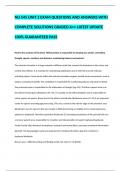Exam (elaborations)
NU 545 UNIT 2 EXAM QUESTIONS AND ANSWERS WITH COMPLETE SOLUTIONS GRADED A++ LATEST UPDATE 100% GUARANTEED PASS
- Course
- Institution
NU 545 UNIT 2 EXAM QUESTIONS AND ANSWERS WITH COMPLETE SOLUTIONS GRADED A++ LATEST UPDATE 100% GUARANTEED PASS Review the anatomy of the brain. Which portion is responsible for keeping you awake, controlling thought, speech, emotions and behavior, maintaining balance and posture? The reticular ...
[Show more]



